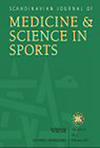限制血流阻力运动与神经肌肉运动对成人慢性膝骨关节炎患者机械肌肉功能的影响——一项随机对照试验的二次分析
IF 3.8
2区 医学
Q1 SPORT SCIENCES
引用次数: 0
摘要
膝骨关节炎(膝OA)是世界范围内的一种常见疾病。全球公认的膝关节OA康复指南包括患者教育和神经肌肉锻炼(NEMEX)。虽然大负荷阻力运动(70%-90% 1RM)经常引起膝关节OA疼痛,但引入低负荷运动(20%-40% 1RM)联合部分血流限制(BFR-RE),但不会引起过度的膝关节疼痛。本研究旨在比较NEMEX和BFR-RE对膝关节OA患者机械肌肉功能的影响。96例(年龄56.7±7.6岁;47名男性,49名女性)有症状的膝关节骨性关节炎,随机分配到自由流动的陆基NEMEX或单侧基于机器的BFR-RE。两组在接受患者教育的同时,每两周进行一次锻炼,持续12周。从基线到12周测量的结果包括最大等距膝关节伸肌力量(MVIC)、力发展率(RFD)、最大腿伸肌力量(LEP)和股直肌(RF)和股外侧肌(VL)的横截面积(mCSA)。差异有统计学意义(p 0.05)。组间比较显示,BFR-RE在所有结局中均有较大改善(p < 0.01)。BFR-RE在增强膝关节OA患者的机械肌肉功能和膝关节伸肌mCSA方面优于NEMEX。BFR-RE观察到的增强的生理反应表明,这种运动方式应被视为膝关节OA患者未来治疗方案的辅助治疗工具。本文章由计算机程序翻译,如有差异,请以英文原文为准。
Effects of Blood-Flow Restricted Resistance Exercise Versus Neuromuscular Exercise on Mechanical Muscle Function in Adults With Chronic Knee Osteoarthritis-A Secondary Analysis From a Randomized Controlled Trial.
Knee osteoarthritis (knee OA) is a prevalent condition worldwide. Globally recognized rehabilitation guidelines for knee OA include patient education and neuromuscular exercises (NEMEX). While heavy-load resistance exercise (70%-90% 1RM) often induces pain with knee OA, low-load exercise (20%-40% 1RM) combined with partial blood-flow restriction (BFR-RE) has been introduced without inducing excessive knee joint pain. The present study aimed to compare the effects of NEMEX and BFR-RE on mechanical muscle function in knee OA individuals. Ninety-six participants (age 56.7 ± 7.6; 47 males, 49 females) with symptomatic, radiographic knee OA were randomized to free-flow land-based NEMEX or unilateral machine-based BFR-RE. Both groups exercised biweekly for 12 weeks while also receiving patient education. Outcomes measured from baseline to 12 weeks included maximal isometric knee extensor strength (MVIC), rate of force development (RFD), maximal leg extensor power (LEP), and cross-sectional area (mCSA) of rectus femoris (RF) and vastus lateralis (VL). Significant (p < 0.01) within-group improvements from baseline to 12 weeks were observed in both groups for MVIC (BFR-RE: +0.4 vs. NEMEX: +0.1 Nm/kg), LEP (+0.6 vs. +0.2 W/kg), mCSA for RF (+1.8 vs. +0.6 cm2), and VL (+3.7 vs. +1.0 cm2). BFR-RE led to increases in RFD (+2.11 (50-ms), +4.48 (200-ms) Nm/s/kg) (p < 0.01), whereas NEMEX did not (p > 0.05). Between-group comparisons revealed greater improvements with BFR-RE for all outcomes (p < 0.01). BFR-RE appears superior to NEMEX in enhancing mechanical muscle function and knee extensor mCSA in knee OA individuals. The enhanced physiological responses observed with BFR-RE suggest that this exercise modality should be considered as an adjunct therapeutic tool in future treatment protocols for knee OA patients.
求助全文
通过发布文献求助,成功后即可免费获取论文全文。
去求助
来源期刊
CiteScore
7.90
自引率
4.90%
发文量
162
审稿时长
3 months
期刊介绍:
The Scandinavian Journal of Medicine & Science in Sports is a multidisciplinary journal published 12 times per year under the auspices of the Scandinavian Foundation of Medicine and Science in Sports.
It aims to publish high quality and impactful articles in the fields of orthopaedics, rehabilitation and sports medicine, exercise physiology and biochemistry, biomechanics and motor control, health and disease relating to sport, exercise and physical activity, as well as on the social and behavioural aspects of sport and exercise.

 求助内容:
求助内容: 应助结果提醒方式:
应助结果提醒方式:


